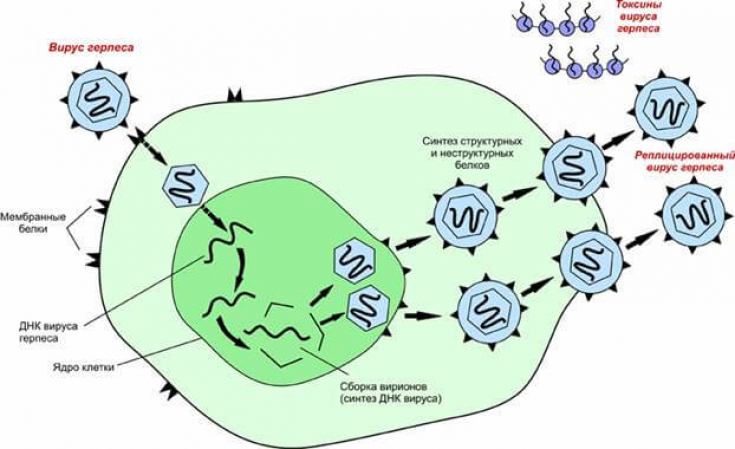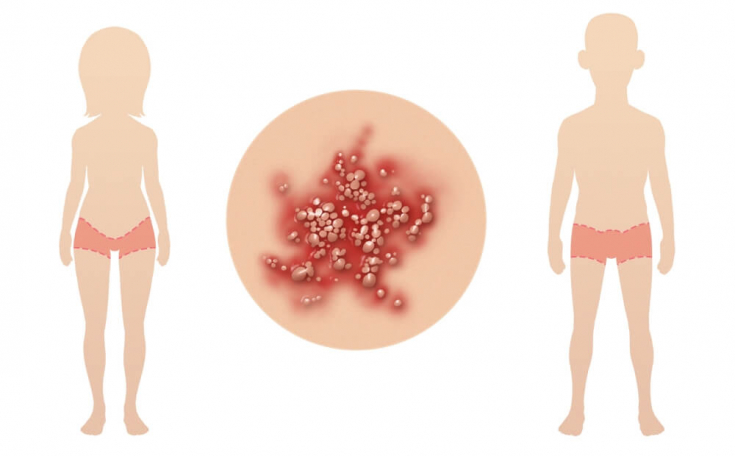Herpetic infection is a fairly common human disease. According to WHO, this infection is in second place after influenza, and is also second by frequency, the cause of death from viral diseases. In seroepidemiological studies, antibodies to the herpes simplex virus are detected in serum, which indicates a high prevalence of herpes infection. In adults, the percentage reaches 90% of cases, and in 73% antibodies are found against HSV-2, which mainly causes genital herpes.
Read more on estet-portal.com how the herpes virus affects the immune processes in the body.
- The main properties of the causative agent of herpes infection
- The behavior of the herpes simplex virus in the body
- What is the danger of herpes infection
- The effect of herpes infection on immune processes
- The unique ability of latent existence of the herpes virus
The main properties of the causative agent of herpetic infection
The causative agent of herpes infection belongs to the family of herpes viruses (Herpes viridae). Now more than 60 types of herpes simplex viruses are known , however, only 8 of them are pathogenic for humans. The causative agent of herpetic infection is very resistant to environmental influences.
For example, at a temperature of -70 degrees, the virus can persist for a very long time. But at a temperature of +50 degrees, the virus is inactivated within 30 minutes, due to its thermolability.
Also, the herpes virus loses its virulence under the influence of x-rays and ultraviolet radiation.
Read also: Herpes virus in the practice of a dentist
:
the causative agent of herpetic infection develops- intracellularly
- and is capable of infecting practically all organs and systems, causing different forms of infection – acute, latent, chronic; the main feature of herpes infection is the ability to persist in the body throughout life
- and provoke various diseases in immunodeficiency conditions; Infection with herpetic infection occurs precisely in childhood. As a result, by 5-6 years of age approximately 80% of children
- are affected.
Effective prevention of herpes zoster The herpes simplex virus is able to integrate into the genetic apparatus of its host cell and remains in this form for
the whole life. The behavior of the herpes simplex virus in the body
under favorable conditions for it, and new virions infect the cell, getting into the lymphatic vessels, then into the blood, namely into the blood cells.

. In the case of a normal immune response, the herpes virus is eliminated from tissues and organs, except for the paravertebral sensory ganglia, where they remain in a latent state until the end of life.
Read more of ourarticles on Facebook! When there is insufficient activity of macrophages, cytotoxic lymphocytes and T cells, as well as a decrease in the secretion of mediators of the immune system,
the virus is activated. What is the danger of herpes infection
The danger of herpetic infection is
direct oncogenic action, which has been proven in practice. This is manifested by a violation of the function of proto-oncogenes, which leads to the development of cancer of the vagina and cervix in women, and also prostate cancer in men (in case of genital herpes).

Asymptomatic carriage of the virus in women is a risk factor for congenital herpes infection in children in 75%, as well as habitual miscarriages.
In addition, the mechanism of immunosuppressive action on immunocompetent cells with further formation of circulating immune complexes has been proven.
Read also:Genital herpes: the main drugs for the treatment of the disease The processes described above can lead to
damage to spermatozoain men in the form of impaired gamete motility and the formation of antisperm antibodies. All this leads to development of male infertility. Influence of herpetic infection on immune processes
At the end of the 20th century, L.N. Khakhalin found that in patients with a recurrent form of genital herpes infection,
specific immunodeficiency is observed.It is based on the unique ability of replicating viruses and active viruses to produce a protein that blocks the genes of the HLA system, which prevents the immune system from controlling the infection.
It has been proven that during a herpes infection, herpes simplex viruses can not only parasitize in blood cells, but alsoadsorb on the surface of microbes
, which enables them to penetrate into the cytoplasm of the microorganism cell. Such localization of the virus interferes with the action of the body's defenses. At the same time, a double infection causes an increase in the action of the herpetic process on tissues and organs, which can contribute to generalization of herpetic infections. The unique ability of the latent existence of the herpes virus
The most important property of the herpes simplex virus is its ability to
inactive existence in the body. Latent infectionis the result of the presence of the virus in the ganglion cells of the nervous system. There is another mechanism recurrence of genital herpes infection, which is manifested by the constant release of the virus from the sacral ganglia.
Read also:Evidence-based medicine: immunomodulators in the treatment of herpes As soon as the threshold of the content of viral particles exceeds its norm, a clinical form of herpetic infection develops in the genitals. Such herpes is very
recurrent. Thus, about 30 million adults in the United States of America have recurrent genital herpes, while more than 500,000 new cases are registered annually. ;In most cases, the recurrent course of herpes infection in the genitals has a subclinical form. What methods of treatment of herpes infection are relevant today, as well as which groups of drugs it is advisable to use, read in our articles.
More useful information on our channel in







Add a comment